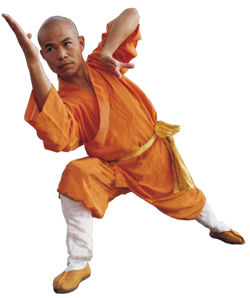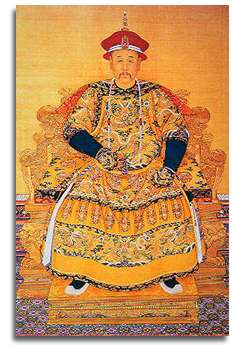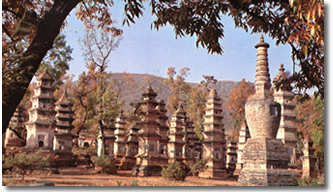
The name Bak Sil Lum immediately betrays a southern accent. This is a Cantonese term, the language of south China. Beijing (which literally means "North Capital") has mandated that the official language of China is not Cantonese but Mandarin, the language of the north. In Mandarin, Bak Sil Lum becomes Bei Shao Lin. That's the same "Bei" as in "Beijing" and the same "Shao Lin" as in Shaolin Temple. Bak Sil Lum is Northern Shaolin and until recently, Bak Sil Lum defined Shaolin kungfu outside the People's Republic of China (PRC.)
Unlike Sil Lum Fut Gar, Shaolin Eagle Claw, or even Shaolin-Do, Bak Sil Lum is Shaolin straight up, no mixer. Those other styles, while claiming a Shaolin heritage, acknowledge outside influence within their very name. Bak Sil Lum's only distinction is that it is from the north, otherwise, it's the pure stuff. Or is it? Currently within the PRC, the original Shaolin Temple at Songshan in Henan Province espouses a completely different curriculum. Bak Sil Lum forms are not practiced at Shaolin Temple today. This absence is amidst claims that Shaolin Temple only espouses modern wushu now. So when it comes to real Shaolin, which is your cup of tea - Northern Shaolin with a southern drawl or the PRC reconstructed Shaolin? My personal practice has been devoted primarily to Bak Sil Lum and I'm embarrassed to admit how long I've trained in it given my rather mediocre skills. Nevertheless Bak Sil Lum inspired me to journey to the original Shaolin Temple for the 1500th anniversary in 1995. Despite entirely different forms, I have been going back and following monks ever since. I continue to practice both systems. Between Songshan Shaolin Temple kungfu and Bak Sil Lum, there is no question in my mind which of the two is real Shaolin. So which is the one? Well, to understand the one, one must first understand the two.
Shaolin versus the Manchus
Shaolin Temple is part of China's soul. Revered as the mystical training grounds where young aspirants were forged into legendary heroes, the emperors always made special pilgrimages to Shaolin Temple to give offerings. This demonstrates the unique relationship between the temple and the ruling dynasties; Shaolin is a source of tremendous power that even the emperors acknowledged. Throughout history, Shaolin has had a hand in the turnover of many a dynasty, just as China's rulers have had a profound influence on Shaolin. And with Shaolin Temple's 1500+year existence, that's a lot of Chinese history. Fortunately, for the relationship between Songshan Shaolin kungfu and Bak Sil Lum, just a fifth of Shaolin's past need be examined, only back to the Qing dynasty, a century before the birth of the United States of America.
Chinese folk tales are brimming with stories of Shaolin heroes that were part of a revolutionary underground opposing China's final dynasty, the Qing (pronounced Ching.) Popular legend asserts that the Qing destroyed the southern Shaolin Temple, burning it to the ground for insurrection. Although sources differ about when this happened exactly, recent archaeological digs in the southern province of Fujian seem to point to the latter 1600's, soon after the Qing came to power. A probable period for the burning might have been during the reign of the first Qing emperor, Shunzhi (1644-1661.) In 1646, Shunzhi subjugated Fujian, Zhejiang and Sichuan. A year later Guangzhou (Canton) fell to him as well. While conquering the south, he was more likely to have destroyed the temple than his successor. The second Qing Emperor Kangxi (1661-1722) was a great supporter of Shaolin Temple. He even wrote the famous characters for Shaolinsi ("si" means temple) for Shaolin's famous placard in Henan, so it is unlikely he would have burned the place he venerated. However, most scholars beleive that it was Kangxi. Whatever the exact date may have been, according to the southern temple legend the renegade monks and their disciples that survived the destruction of the southern temple became the forefathers (and foremothers) of many of today's most famous styles such as Wing Chun and Hung Gar. Consequently, kungfu movie after kungfu movie vilifies the Qing. But beyond this cinematic condemnation, few Western enthusiasts really know China's last dynasty.
The notorious Qing Dynasty ruled over China from 1644 to 1911. They were actually Manchus, descendents of the Jin Tartars, the rulers of northern China several centuries earlier. Despite having power over China for more than two and a half centuries, the Manchus never embodied more than two percent of the population of China and were considered foreigners. The infamous queue, a shaved forehead and long braid of hair, was actually a forced upon Chinese men as sign of subjugation to the Qing. "Qing" was actually an adopted name, echoing the previous dynasty, the Ming. Ming means "bright." Ironically, Qing means "pure."
Shaolin versus Emperor Yongzheng
 Many Shaolin heroes, like Hung Hay Kwun, Fong Sai Yuk, Lu Siniang and Gan Fengchi, were resistance fighters opposing the Qing. Gan Fengchi is attributed as the founder of Bak Sil Lum and Hua Quan (flower boxing.) He is a popular figure in Chinese folk tales, but not as well known in the West because unlike the others, his legends weren't made into movies. Just like the founder of Hung Gar, Hung Hay Kwun, Gan Fengchi was a layman disciple of a Shaolin monk who brought kungfu out of the temple and into the resistance.
Many Shaolin heroes, like Hung Hay Kwun, Fong Sai Yuk, Lu Siniang and Gan Fengchi, were resistance fighters opposing the Qing. Gan Fengchi is attributed as the founder of Bak Sil Lum and Hua Quan (flower boxing.) He is a popular figure in Chinese folk tales, but not as well known in the West because unlike the others, his legends weren't made into movies. Just like the founder of Hung Gar, Hung Hay Kwun, Gan Fengchi was a layman disciple of a Shaolin monk who brought kungfu out of the temple and into the resistance.
Gan lived under the reign of the 3rd Qing emperor, Yongzheng (1723-1735) one of the more villainous rulers of that dynasty. Emperor Yongzheng had the unfortunate position sandwiched between two of the greatest Qing dynasties emperors, Kangxi and Qianlong, and he paled by comparison. Kangxi reigned longer than any other emperor of China and throughout his reign China prospered. Qianlong advanced China more than any other emperor. In contrast, even Yongzheng's right to rule was doubtful.
Of Kangxi's 36 sons, Yongzheng, the son of a maidservant, was the most unlikely candidate, so there remains a lot of skepticism about his right to succeed. Many believe he ascended through political intrigue and ruthless treachery. Yongzheng was directly responsible for the decline of Shaolin. Under his rule, all kungfu weapon training was banned. Defiance was punishable by death. The temple had to hide all of its weapons, but the monks still trained in secret. It would not be the last time Shaolin teachings were prohibited.
Many of Gan's legends are about direct confrontations with Emperor Yongzheng. While Gan usually emerged triumphant, in the 7th year of Yongzheng's rule, the emperor had over a 100 people arrested for civil disobedience, including Gan. By this time, firearms already had become the dominant weapon, so kungfu masters of Gan's generation had a new challenge to face - the threat of becoming obsolete. This too would weigh heavily on the development of kungfu and the status of Shaolin until the present day. Nevertheless, Gan passed Bak Sil Lum on to his student Wan Bengcai, beginning a new tradition that has survived until today.

Shaolin versus the Foreign Powers
Despite Yongzheng's bad reputation, it was his 4th son, the 4th Qing Emperor Qianlong (1736-1795) who expanded China to its highest level ever. After 4 decades of holding the mandate of heaven, Qianlong's China became the richest and most populated nation in the world, the zenith of Qing culture. Another supporter of Shaolin, history documents that when Qianlong made his pilgrimage to the Songshan temple, he uncharacteristically spent a night in the Abbot quarters. It was a demonstration of the high regard he held for Shaolin.
Even so, the end of Qianlong's illustrious reign brought ill omens. The British Lord George Macartney attempted to increase trade with China by making an opulent offering of gifts to Qianlong on his 83rd birthday. Unfortunately, Macartney was unaware of the magnitude of reverence placed upon the Emperor and made the cultural faux pas of refusing to kowtow to him. This was a warning sign; China and the West were headed on a collision course. After Macartney's mission failed, Britain resorted to another method - opium.
Meanwhile, anti-Qing sentiment rose high amongst the Chinese. Secret societies, often with dubious connections to Shaolin, began to a new underground resistance. With pressure from the Triads, the Hung Clan and the White Lotus Society, the Opium War erupted in 1840. British and French troops seized and looted Beijing, and China was forced to sign a humiliating treaty. The treaty of Nanjing (South Capital) opened five ports to foreign trade, as well as ceding Hong Kong to Britain. Less than a decade after the Opium War, the anti-Qing pro-Christian Taiping Rebellion battered the dynasty some more for almost a decade and a half, costing over 20 million lives. Its leader Hong Xiuchuan, believing he was the younger brother of Jesus Christ, seized Nanjing in 1853. This was the largest peasant uprising China ever saw, only quelled with the assistance of the British military, as well as European and U.S.A. mercenaries. At the turn of the century, the Anti-Christian, Anti-foreign Boxer Uprising so weakened Beijing that the Qing government was again at the mercy of foreign nations, ironically the very foreign devils that the Boxers opposed. Austria, Belgium, Britain, France, Germany, Holland, Japan and the USA all took advantage, sacking Beijing once more. The last of China's mighty dynasties sank into history as the child Emperor Puyi, the last of his kind, was ousted in 1911 at age six. China has lost its most revered tradition and international face under Qing rule.
For part 2, click here
About
Gene Ching :
![]() Written by Gene Ching for KUNGFUMAGAZINE.COM
Written by Gene Ching for KUNGFUMAGAZINE.COM
![]() Print Friendly Version of This Article
Print Friendly Version of This Article















